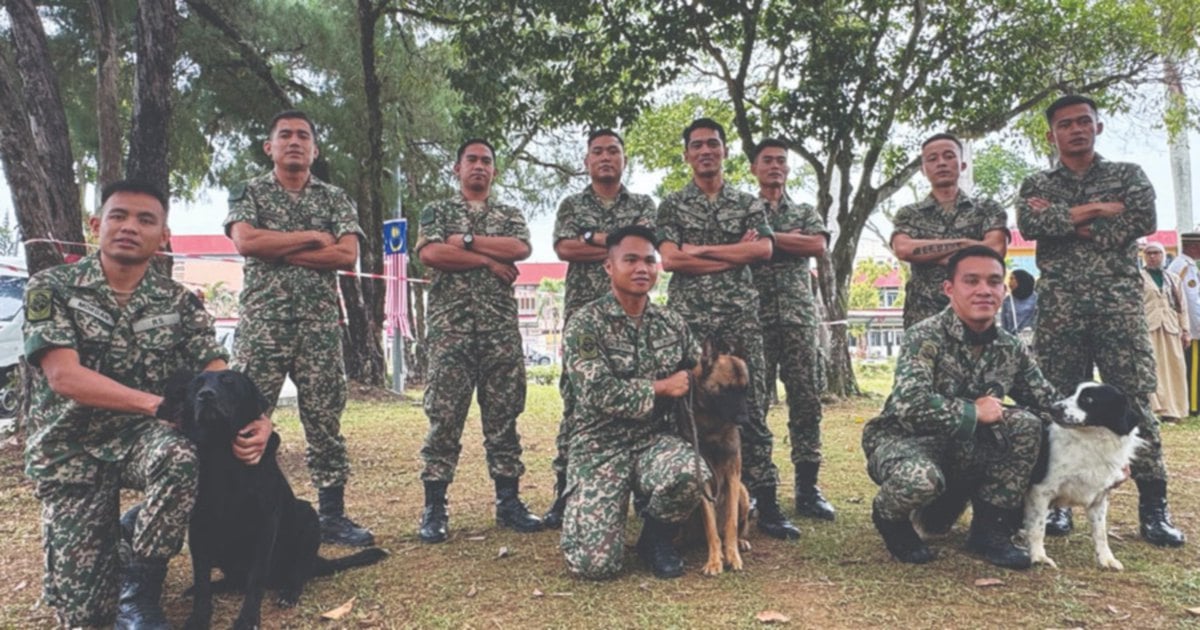KUALA LUMPUR: At the Army Combat Training Centre (Pulada), a silent team of warriors patrols the grounds.
They do not carry rifles or radios, but their keen senses and unwavering loyalty make them among the army’s most formidable assets.
They are the dogs of the Military Dog Wing, known as the Wolf Wing.
Dogs have played a role in warfare for millennia, serving as combatants, scouts, sentries, messengers, mercy dogs and trackers.
Many of these roles continue in modern military use, where canines provide capabilities that humans cannot replicate.
Wolf Wing’s assistant head Captain Duin Tat said the army’s canine programme goes back to 1971, under the Jungle Warfare School.
“We started with 12 dogs, followed by another 12 in 1972. Today, the unit has a full capacity of 96 dogs,” he told the New Straits Times.
The Wolf Wing trains dogs for three specialised roles: guarding, tracking and operational assistance.
“Guard dogs patrol ammunition depots, borders and key military installations, keeping watch over critical assets. Tracker dogs follow scents in search-and-rescue missions, while others are trained to detect explosives.
“Most of the dogs are sourced from the United Kingdom with the Wolf Wing comprising German Shepherds, Belgian Shepherds and Rottweilers for guard duties, and Labradors, Springer Spaniels and Pointers for tracking and detection.
“Our dogs can detect enemies 150m away. They can even smell explosives.
“During the communist insurgency, these dogs were invaluable in providing early warning before any attack.”
Forging four-legged warriors
Duin said training is rigorous for the four-legged warriors as puppies under 2 years old are taken into the programme, and after six months of intensive training, they are paired with a handler.
“Each dog has its own personality. Some are stubborn, some are cautious. Making them obedient takes patience and consistency.
“It takes three phases of training: basic, moderate and full. In the early stages, dogs learn controlled biting (with trainers) using gloves and boots.
“Later, they ‘graduate’ to full protective gear (used by trainers), simulating real combat conditions.
“They are paired with a handler and their partnership is tested through obedience drills and operational exercises, and the dogs remain in service for up to nine years.
“Conditioning extends to battlefield sounds. The dogs are trained not to be startled by gunfire. In fact, they become more lively when they hear it,” he said.
Unlike other forces, said Duin, the army does not assign a permanent handler to each dog immediately; instead, handlers rotate, ensuring the dogs adapt to different commands and situations.
He added that daily routines are equally structured and continuous to ensure the canines do not lose their skills.
“Grooming begins each morning, after which handlers spend six to eight hours a day rotating through exercises with each dog. This ensures every dog receives individual attention, maintaining peak physical fitness and reinforcing operational skills.”
Within the Wolf Wing, each dog has a distinct personality.
Kaiser, a 7-year-old Labrador used as a tracker, is known for his calm and obedient nature.
Nala, the unit’s only female and a Belgian Malinois guard dog, is fiercely aggressive and fearless, guarding key areas with unrelenting vigilance.
Keegan, a black-and-white Border Collie trained for explosive detection, combines sharp intelligence with relentless focus, sniffing out threats humans cannot detect.
Operational deployments
The Wolf Wing has been deployed in operations across Malaysia, ranging from tracking illegal immigrants to SAR missions.
During Op Merpati I in Tanjung Sepang in Johor, the team’s tracker dogs successfully traced illegal migrants attempting to enter the country.
Meanwhile, in Op Pagar II in Bukit Kayu Hitam, Kedah, they identified escape routes used by illegal immigrants, assisting the main operational units in their pursuit.
The Wolf Wing’s expertise also extends to disaster response.
In 1996’s Op Typhoon Greg in Sabah, the team traced 17 bodies over 10 days after a storm struck the district.
In Op Gunung Pulai in Johor, they assisted in recovering victims swept away by flash floods, while in Op Tohoi in Gua Musang in 2015, they contributed to the search for missing children in riverside areas.
Most notably, in December 2022, the team was deployed to Batang Kali in Selangor, searching landslide-affected areas over nine days, covering 100 sq m per day.
Strategic value
Duin said these dogs are more than “pets” – they are strategic assets.
He said the dogs carry secrets of military operations, a responsibility that continues even after their service ends.
For this reason, retired dogs are not adopted by the public.
“If their training methods were revealed, it could expose vulnerabilities to adversaries. That’s why operational security is paramount,” he said.
Unfazed by gunfire, alert to threats and fiercely loyal, the Wolf Wing’s four-legged warriors prove that sometimes, the fiercest defenders walk on four legs — even when their service comes to an end.
© New Straits Times Press (M) Bhd






